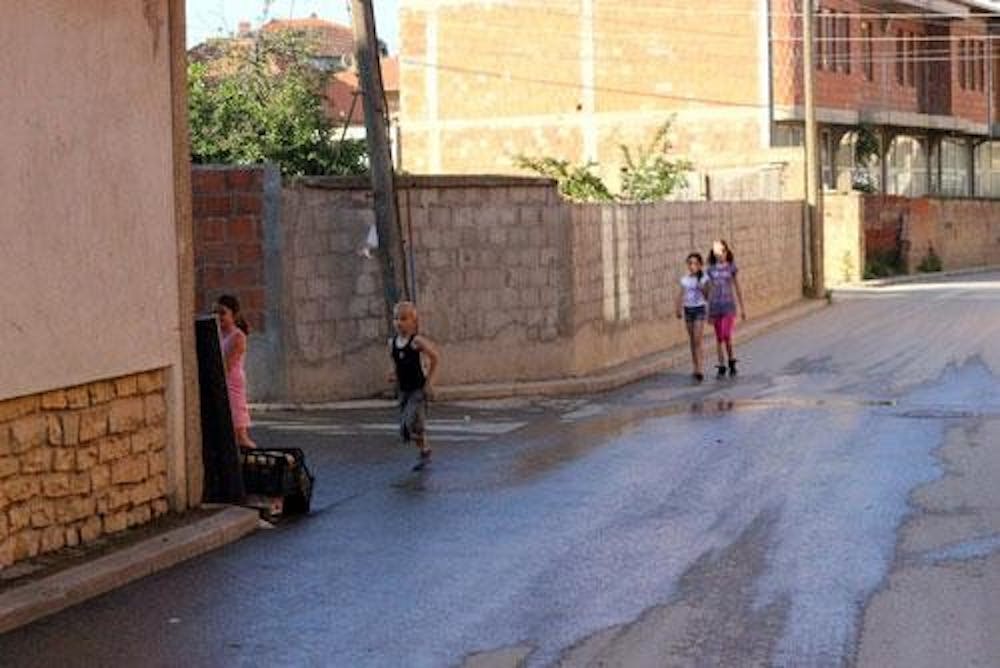
Children play together in the watered streets of a Roma community in the outskirts of Prishtina, the capital of Kosovo. (Nicole Theodore | The Miami Student)
The world has turned its attention to Greece this week after a blonde haired, blue-eyed girl was found in a Roma camp in the provincial capital of Larrisa, and was discovered to have been abducted from her biological family.
The police found the little girl peeking out from under a blanket when they raided the camp, searching for drugs and guns. Because the girl looked nothing like her Roma parents, police were suspicious and asked the parents for legal birth documents for the girl, now known as Maria. They were found to be fraudulent. Authorities later discovered the Roma woman claiming to be Maria's mother actually had two identities and had been living off thousands of euros a month in child benefits. She and her husband were arrested for falsifying documents and abduction.
Maria's case is not unusual: thousands of voices have raised concerns of increased abduction linked to human trafficking within the Roma communities of Southeastern Europe. In 2010, police arrested Romanian gang members who kidnapped almost 200 children, bringing them to Britain to steal or beg for money according to The Telegraph. Some of the children were deliberately mutilated to appear disabled, to increase their "earning potential." Forced child begging is seen throughout most of the Balkans, and it's common to see a mother holding a disfigured child wrapped in a blanket, begging in major cities.
According to a 2012 report from The United Nations Office on Drugs and Crime (UNODC), the most common origin of victims of cross-border trafficking in Western and Central Europe is the Balkans, where 30 percent of victims of cross-border trafficking are nationals from that area. Twenty-seven percent of all victims detected globally are children.
Between 6.8 and 8.7 million Roma, or gypsies, as some know them, live in Europe. The Romas are susceptible to increased trafficking of children due to poor social conditions, work and ethnic discrimination, lack of education and limited access to proper housing. About 90 percent of Romas live in households below national poverty lines and less than one third of them have paid employment according to a 2011 United Nations Development Program report.
Even though 56 percent of human trafficking went toward the sex industry in 2012, 36 percent of human trafficking ends in forced labor, including forced begging according to UNODC. Little girls like Maria are often sold by family members to third parties, or are forced by their own families to beg, steal or sell throughout the streets, only allowed to come home when they make enough money. The repercussions a child faces if they do not complete their tasks may end in beatings, threats, psychological abuse and starvation.
I met a 12-year-old boy named Ardid in Prishtina, Kosovo this summer who sold gum during the day and peanuts at night until 4 a.m. every single day. He had dropped out of school, and worked alongside his 15-year-old brother who sold cigarettes. He was often exhausted with bags under his eyes, his shirts hanging off his body. I always asked myself "What can I do?"
According to the UNODC, children and teenagers who are forced to beg and sell are usually unable to seek help because they may not know the language of the country, or they are reluctant to report their circumstances because their trafficker tends to be someone they know. Ardid told me he sold gum and peanuts because his mother was sick and his father was an alcoholic. This seemed to be the same story for most children in Prishtina.
It took a little blonde girl who looked nothing like her Roma family to awaken the rest of the world to issues facing untold numbers of children. Fraudulent birth documents, child abduction and trafficking, forced begging and forced slavery are only some of the horrors these children face.
Even though it hasn't been concluded whether or not Maria was forced to beg for her family, it raises the question of how many other children have been abducted in order to generate income. It's hard not to wonder about other helpless children out there who are also in Maria's position, and wondering when someone will notice them.




